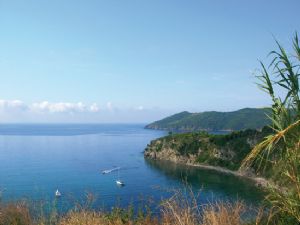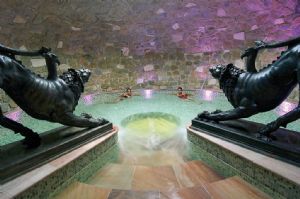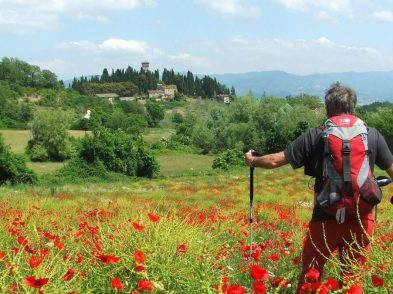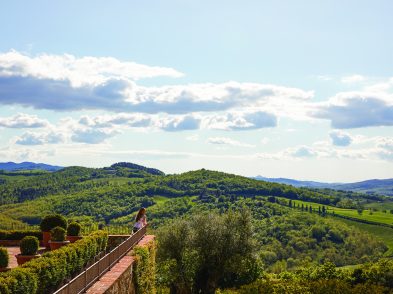A few weekends ago, a friend took me for a drive through the Casentino, a magical mountainous region between Florence and Arezzo. I had never heard of ‘Casentino’ and, frankly, my arm needed a little twisting. Little did I know, I was about experience some of the most amazing scenery in all of Italy, turreted castles right out of a fairytale, churches adorned with precious art by Renaissance masters, and a massive national park with endless hiking trails.
November, when the trees paint the forest in gold and amber hues and porcino mushrooms and chestnuts flavor local menus, is an ideal month to visit Casentino. I recommend a Sunday when the churches and sights are open. You will need a car and a good map (yes, even if you have a GPS). There is too much to see and do in one day, but this itinerary will introduce you to the region and, I hope, inspire future visits.
The easiest and most beautiful way to reach the Casentino from Florence is to drive east through Pontassieve, then climb the Passo della Consuma, a mountain pass that winds through a glowing green countryside sprinkled with enchanted forests and tiny villages with curious names like Omomorto (‘dead man’). A little log cabin halfway up the pass is a great place to stop for a cappuccino and a slice of schiacciata con l’uva.
Continuing up the pass, keep an eye out for the left turn to Stia. On the right, follow the sign to the Pieve della Romena. As you round a bend in the narrow road, seemingly out of nowhere emerges a gently rounded, neatly columned Romanesque church in shades of soft grey. The locals speak with great affection for the priest, Don Luigi, who on Sunday evenings draws a crowd of more than 100 people in the twelfth-century church’s bare, graceful interior.
Perched a few kilometers above the church looms the fairytale-like Castello di Romena, complete with a drawbridge and a prison tower that was allegedly the inspiration for the circles of hell in Dante’s Inferno. Built in the tenth century by the counts of Guidi, the castle once had 14 towers and was the most powerful in the region. The little museum is moderately interesting, but the views from the dramatic cypress-bordered grounds alone are worth the 3 euro entry fee. Further down the road is Stia, historically one of the most important wool-making centers in Italy.
Ristorante Falterona Gliaccaniti in piazza Tanucci is best known for its funghi, Chianina beef, and fish from Viareggio, all prepared with the creative twist of Casentino cuisine. My thinly sliced fresh porcini con rucola and pecorino was accented with pink peppercorns. Also on the menu is bottled water produced by Pierre Cardin from the spring in Stia. Apparently, the French fashion designer vacationed here and loved the ultra-fresh water so much that he bought the spring and sells the bottles at his restaurant, Maxim’s, in Paris, and a few other select locales.
During our lunch, Marco, the owner, shared one of the best-kept secrets of the Casentino: the Chiesa della Santa Maria delle Grazie, a sweet little church just down the road from Stia. When we arrived, the sprightly, elderly caretaker, Antonietta, graciously opened the door to this wondrous shrine built in the 1430s. Inside, five beautifully preserved fifteenth-century ceramic reliefs from the school of Della Robbia exude purity and grace in their signature colors of pale blue and white. I was also amazed to find a beautiful fresco by Florentine Renaissance painter Domenico Ghirlandaio. (If the church is not open, knock on apartment 2 around back and Antonietta will happily let you in)
The Castello di Porciano, also on the outskirts of Stia, is a private museum and home of its current owner, whose parents lovingly restored the dilapidated ruin in the 1960s. I was immediately charmed by this eleventh-century castle, its walls, well and tower cloaked in lush, red ivy. It is open only Sundays from 10am to 12pm and 4pm to 7pm, but is still worth a look, even if closed.
The picturesque town of Poppi, only a 20-minute drive from Stia and the most important historical center in the Casentino, is my favorite town in the region. As you ascend the road leading into the city center, a grand gazebo beckons visitors to take in the views of the countryside under its elegant dome. In the main piazza, an inviting little six-sided chapel is lavishly frescoed. The abbey of San Fedele at the end of the porticoed lane in front of the chapel features a crucifix by Taddeo Gaddi, a prized student of Giotto.
Atop the hill, the commanding and remarkably well-preserved Castello dei Conti Guidi might look familiar. Its right half was designed by Florentine architect Arnolfo di Cambio, architect of the Palazzo Vecchio in Florence. Inside the thirteenth-century castle, opposite five ceramic coats of arms from the Della Robbia school, an exquisite stone staircase curves up to a striking dark wooden balcony. At its top stands a statue of one of the Guidi counts, said to still haunt the castle’s halls. As you enter the castle’s small chapel, you’ll be surrounded by faded frescoes by Gaddi on the vaulted ceiling and walls.
The cozy and refined L’Antica Cantina Ristorante on via Lapucci is a wonderful place to stop for a long, relaxing lunch. For a sampling of local fare, try the chestnut-flour tagliatelle with bacon, walnuts, pine nuts and raisins, and the savory veal filet with figs and gorgonzola, paired with a bottle of Crognolo from the Tenuta Setteponti winery down the road in Arezzo.
Three castles, two towns, a few churches and two restaurants might be enough for one day. However, if you still have the energy, consider a drive through the pine and beech forests of the Parco Nazionale delle Foreste Casentinesi to the Benedictine monastery and hermitage of Camaldoli. At the monastery, founded in 1052, more than 100 monks grow their own food and produce liquors, honey, soaps and other products sold in the farmacia. Farther up the road, Eremo di Camaldoli, where the monks live in a cluster of small cottages, is often shrouded in an eerie, chilling fog. Inside its brilliantly frescoed and gilded baroque church decorated by Giorgio Vasari, a tiny chapel holds an exquisite ceramic relief by Andrea della Robbia.
These are but a sample of the many charms of the Casentino. In the spring, after the snow has melted and the roads are accessible, I plan to visit La Verna, a thriving monastic community; St. Francis is said to have received the stigmata in a nearby cave.
Getting there
From Florence, head east along the Arno to via Arentina, which eventually becomes the SP70. After Pontassieve, where the road merges with a larger highway, veer right following the sign to Pontassieve (even though you already passed through it) not straight towards Rufina. A few kilometers later turn left onto Passo della Consuma.








